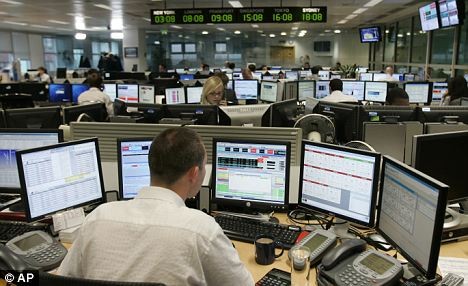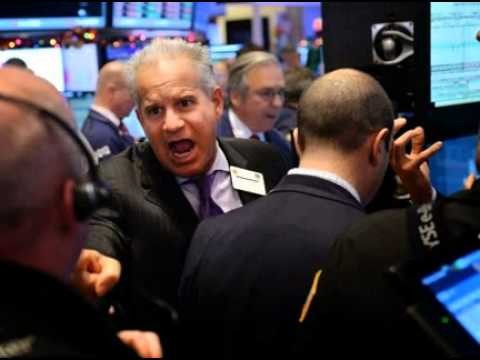Stocks end mixed in volatile seesaw trading
Post on: 9 Июнь, 2015 No Comment

If you’re a long-term investor, you should ignore days like Wednesday’s market rout. In a decade or two, it won’t mean a thing. (AmericasMarkets, USA Today)
A man looks at closing information of Tokyos Nikkei Stock Average in Tokyo on Oct. 16. (Photo: KIMIMASA MAYAMA, EPA)
Wall Street’s ride on the volatility rollercoaster isn’t over, but in yet another day of erratic price swings, the market’s attempts to end in positive territory provided mixed results Thursday, as angst-ridden investors weigh investment opportunities against slowing economic growth prospects, rising Ebola fears and the prospects of a prolonged market correction.
The Dow Jones industrial average — down over 200 points in early trading, ended off 24.5 points to 16,117. It was Dow’s sixth straight loss, the longest losing streak since August 2013 and the blue chip barometer’s lowest close since April 11. The Standard & Poors 500 stock index added 0.27 points to 1,862, while the Nasdaq composite, down 1.3% earlier, rose 2 points to 4,217. The small stock Russell 2000 climbed 1.5% to 1,088, it’s third straight gain.
The mood of the market, however, remains pessimistic, as Asian markets were battered earlier, while European exchanges extended Wednesday’s losses. Japan’s Nikkei 225 sank 2.2%, and the Hang Seng was off 1%, while Britain’s FTSE 100 was off 0.25% and France’s CAC 40 fell 0.5%. Germany’s DAX ended virtually flat after Wednesday’s 1% slide.
Gunshy investors largely ignored a fresh spate of good economic news, including a Labor Department report that initial jobless claims had fallen to a seasonally adjusted 264,000 last week — lowest in 14 years. Separately, the Federal Reserve said September industrial output rose 1%, the largest jump since May 2010, offsetting fears that the U.S. economy was being crimped by slowing growth abroad.
Wall Street appeared encouraged by comments from St. Louis Federal Reserve president James Bullard, who said that the Fed should consider extend its bond-buying program to bolster the economy and keep interest rates lows. U.S. Treasuries faltered, sending yields on 10-year notes to 2.16%.
Goldman Sachs CFO Harvey Schwartz said some of selling pressure on stocks was accelerated by so-called stop loss orders, triggered when investors specify a price level that’s breached. The strategy is designed to protect investors from bigger losses.
Advancing issues outpaced losers 2,276 to 918 on the New York Stock Exchange, with 175 stocks hitting fresh 52-week lows.
There’s was little respite from a fresh stream of quarterly corporate earnings reports. After Thursday’s close, Google slumped 1% to $524 after posting lower-than-expected results. Earlier, Goldman Sachs ended down 2.6% to $172.58 despite posting stronger-than-expected earnings. Netflix sank 19% $361.70 on lower subscriber growth, while online retailer eBay fell 4.7% to $47.88 following weaker-than-expected quarterly results and analyst downgrades.
Wall Street was looking for so-called forward guidance to be more positive, as there’s fear that slowing growth abroad will have a negative impact on domestic growth.
Some market analysts also belief stocks must retest Wednesday’s lows before providing more direction. The hope on Wall Street is that yesterday’s huge downdraft and late-day reversal might have marked a so-called capitulation, or price level that marks a selling climax.

Yesterday’s price action did share many factors consistent with a capitulation, Chris Verrone, an analyst at Strategas Research Partners said in a research note. But he added: Don’t rule out a retest of the lows.
t.co/7hRBnMwQMF
USA TODAY Money (@USATODAYmoney) October 16, 2014
Paul Hickey, co-founder of Bespoke Investment Group, told clients in morning report that market volatility is likely to continue. The Dow extended its string of triple-digit moves to 16 out of the past 23 trading sessions.
Price action this morning is ridiculous, with currencies, commodities, interest rates, volatility markets, stocks, and every other financial asset class whipping up and down almost at random, Hickey wrote.
Crude oil prices rose following a spate of daily drops. Benchmark West Texas Intermediate rose 1.2% to $82.74 a barrel, while Brent crude climbed 0.8% to $84.47.














